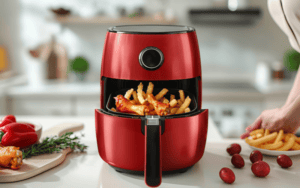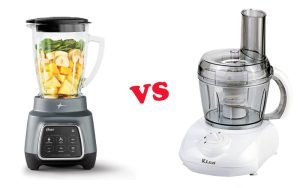So, you want to add a new gadget to your kitchen and aren’t sure what it should be. Well, you are in the right place. We have a similar article on food processor vs blender so you can check that out if you’re having a similar dilemma. In this article, we will focus specifically on immersion blenders (or stick blenders and hand blenders) and how they compare with a food processor.
A Hand Blender And It’s Capabilities

There are quite a few things an immersion blender can do. We have a complete article on immersion blender recipes that you might like to check out. But to put it briefly, an immersion blender is great at bringing ingredients together that would otherwise be a challenge by hand.
How To Use An Immersion Blender?
Most immersion blenders come with a detachable stick, so make sure you have fitted the blender to the motor. Most immersion blenders make a clicking sound when the stick is latched in place. Once the blender is in place, you can start blending sauces, soup, condiments and even cake batter. Since the blades are made such that they pull the ingredients inwards, you must keep the blender at the bottom of the pan, or glass to combine all the ingredients. Some products like mayonnaise, require you to constantly be in contact with the eggs while you are using the stick blender.
If you are blending something in a tall glass, make sure to fill the glass halfway this will protect ingredients from spilling out.
Here are some reasons why you might like an immersion blender:
1. Soups and Sauces: Usually the blending stick is resistant to extreme heat. This is why they are perfect for blending soups and sauces directly in the cooking vessel without the need to transfer hot liquids.
2. Smoothies and Shakes: The blade is designed to create a kind of vortex that pulls all the other ingredients inwards. Hence it’s ideal for a smooth blend needed for smoothies, shakes, or even pureeing fruits for baby food.
3. Whipping Cream: Emulsion blenders with a whisk attachment are excellent for making whipped cream. However, if you don’t have a whisk attachment you can still make whipping cream, it will just take a little longer than it would with a whisk.
4. Emulsions: It is great for making salad dressings, mayonnaise, or emulsifying sauces.
5. Ease of Cleaning: Another reason why people prefer immersion blenders over food processors and other blenders is they have detachable blending shafts that are easy to clean and store.
6. Compact Design: An immersion blender or stick blender does not take up a lot of kitchen space.
A Food Processor and Its Capabilities

As stated above, a food processor can slice, dice, knead, and make certain purees. It is not the best solution for soups and shakes, or anything that is too liquidy, but it is by far a more versatile equipment than a stick blender.
The only con to a food processor is its size. It’s usually larger and clunkier than a stick blender, hence it is not ideal for small kitchens.
How To Use A Food Processor?
A food processor usually comes with a detachable base and blades. Make sure you choose the right blade for the right task, i.e., a chopping blade for chopping and slicing, a kneading blade for doughs etc.
Most food processors are dishwasher safe, however, you must make sure you remove all the parts and wash them.
Here are some reasons why you might like to have a food processor:
1. Chopping and Dicing: A food processor comes with a flat base that is heavy at the base which makes tasks like chopping large quantities of vegetables, nuts, or herbs possible.
2. Slicing and Shredding: It is useful for slicing or shredding vegetables, cheese, or even making coleslaw – something that will take forever if done by hand.
3. Kneading Dough: A food processor can knead bread or pizza dough in seconds; giving you time to spend with friends and family.
4. Pureeing: Although pureeing is always better in an immersion blender, a food processor can make purees as long as the final product is not too watery.
5. Grinding: Some food processors can grind meat or nuts but you have to make sure that your food processor has the right blades and attachments or else it might not take the load.
Immersion Blender vs Food Processor – Which One Should You Choose?
The decision between an immersion blender and a food processor ultimately depends on your cooking habits and the types of dishes you prepare most frequently:
- For Small Tasks and Convenience: Opt for an immersion blender if you frequently blend soups, and sauces, or make small batches of smoothies. Its compact size and ease of use make it a favorite for quick tasks.
- For Larger Volumes and Versatility: Choose a food processor if you often prepare large meals, need precise chopping or slicing, or enjoy experimenting with different recipes that require extensive food preparation.
However, there is a third variant that is the best of both worlds. You can buy a 3-in-1 or a 5-in-one immersion blender; one that comes with a food processor attachment. Most of these are mini food processors because the immersion blender motor cannot power a big model, but it can chop, slice, dice, and knead just like a regular food processor, only in smaller quantities.
Products like the KitchenAid Immersion Blender have everything from the stick blender, and food processor to a whisk attachment. We have written a detailed article on the best immersion blenders of 2024, where you will find out more on this and other blenders in the market.
Conclusion
Both immersion blenders and food processors are essential kitchen tools, each excelling in its own domain. While an immersion blender offers convenience and ease for quick blending tasks, a food processor provides power and versatility for more extensive food preparation needs. Consider your cooking style, the types of dishes you prepare, and the amount of space you have in your kitchen when deciding which one to invest in. Ultimately, having both can complement each other well, ensuring you’re well-equipped to tackle any culinary challenge that comes your way.



















